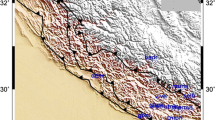Abstract
This paper deals with the characteristics of strain pattern by using permanent GPS stations in South Korea in terms of seismic activity and tectonics. We have estimated patterns and rates of crustal motion strain in South Korea for 2002–2004 by using GPS daily solutions. Eight GPS stations involved in precise baseline vector solution and horizontal strain components were calculated using the differences of baseline length during the time span of three years. The mean rate of maximum shear strain was 0.13 μ/yr. The mean direction of principal axes of compression was about N72°E. This direction is in accordance with the P-axis distribution of focal mechanisms of earthquakes in and around the Korean peninsula.
Similar content being viewed by others
References
Becker, M., Reinhart, E., Nordin, Soeb Bin, Angermann, D., Michel, G., and Reigber, C. (2000). “Improving the velocity field in south and south-east Asia: The third round of GEODYSSEA.” Earth Planets and Space, Vol. 52, pp.721–726.
Blewitt, G. (1989). “Carrier phase ambiguity resolution for the global positioning system applied to geodetic baseline up to 2000 km.” Journal of Geophysical Research, Vol. 94, No. 10, pp. 187–293.
Choi, J.H. and Sato, H. (1995). “Historical damaging earthquakes in the Korean peninsula.” Zisin, Vol. 48, pp. 483–486 (in Japanese).
Dodson, A.H., Shardlow, P.J., Hubbard, L.C.M., Elgered, G., and Jarlemark, P.O.J. (1996). “Wet tropospheric effects on precise relative GPS height determination.” Journal of Geodesy, Vol. 70, pp. 188–202.
Jeager, J.C. (1964). Elasticity, fracture and flow, Methuen, London.
Jun, M.S. (1990). “Tectonic implication of shallow earthquakes in and around the Korean peninsula.” Journal of Uppsala University, Sweden, Vol. 285, pp.1–30.
Lee, K.H. and Jung, H. O. (1980). “A study of instrumental data of earthquakes in the Korean peninsula.” Journal of Geological Society of Korea, Vol. 9, pp. 32–45.
Lee, K.H. (1985). “Studies on the seismic risk of the Korean peninsula (1).” Journal of Geological Society of Korea, Vol. 14, pp. 227–240.
Lichten, S.M. and Border, J.S. (1987). “Strategies for High Precision GPS orbit determination.” Journal of Geophysical Research, Vol. 92, No. 12, pp. 751–762.
McCarthy, D.D. (1996). “IERS conventions: IERS, technical note 2.” Central Bureau of IERS — Observatoire de Paris, p. 95.
Michel, G.W., Becker, M., Angermann, D., Reigber, C., and Reinhart, E. (2000). “Crustal motion in E-and SE-Asia from GPS measurements.” Earth Planets Space, Vol. 52, pp. 713–720.
Richter, C.F. (1958). Elementary Seismology, W. H. Freeman and Company.
Sato, H. (1973). “A study of horizontal deformation of the crust associated with destructive earthquakes in Japan.” Bull. Geogr. Surv. Inst., Vol. 19, pp. 89–130.
Song, D.S. and Yun, H.S. (2007). “Optimal GPS positioning solutions interval for a crustal deformation estimation.” KSCE Journal of Civil Engineering, Vol. 11, No. 4, pp. 193–198.
Stephen, M.L., Sever, Y., Bertiger, W.L., Heflin, M., Hurst, K., Muellerschoen, R.J., Wu, S.C., Yunk, T., and Zumberge, J. (1996). GIPSY-OASIS II: A High Precision GPS Data Processing System and general Satellite Orbit Analysis Tool, Jet Propulsion Laboratory, California Institute of Technology, Pasadena, CA.
Tsukahara, H. and Kobayashi, Y. (1991). “Crustal stress in the central and western part of Japan.” Zisin 2, Vol.44, pp. 221–231 (in Japanese).
Author information
Authors and Affiliations
Corresponding author
Rights and permissions
About this article
Cite this article
Song, DS., Yun, HS. Crustal strain pattern analysis of Korean peninsula using repeated GPS measurements. KSCE J Civ Eng 12, 267–273 (2008). https://doi.org/10.1007/s12205-008-0267-x
Received:
Accepted:
Published:
Issue Date:
DOI: https://doi.org/10.1007/s12205-008-0267-x



